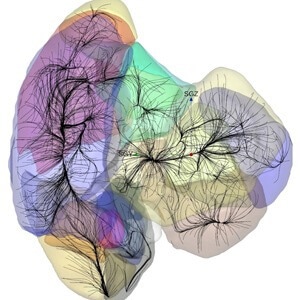Reviewed by Danielle Ellis, B.Sc.Sep 30 2024
In a study published in Nature Astronomy, a group of international researchers led by astronomers at the University of Hawaiʻi Institute for Astronomy is upending the comprehension of the universe with ground-breaking discoveries that imply the cosmic neighborhood may be far larger than previously believed.
 Galaxy motions converge into colored basins of attraction. The Milky Way is shown as the red dot. Image Credit: University of Hawai
Galaxy motions converge into colored basins of attraction. The Milky Way is shown as the red dot. Image Credit: University of Hawai
The Cosmicflows team, through their study of the motions of 56,000 galaxies, has discovered a possible change in the size of the galactic basin of attraction.
Ten years ago, the group concluded that the Milky Way galaxy is located within the massive 500 million light-years across the Laniākea basin of attraction. However, fresh information indicates that this comprehension might only be cursory.
Now, there is a 60 % chance that we are part of a much larger structure, possibly with a tenfold greater volume, that is centered on the Shapley concentration, an area teeming with massive amounts of mass and gravitational attraction.
Our universe is like a giant web, with galaxies lying along filaments and clustering at nodes where gravitational forces pull them together. Just as water flows within watersheds, galaxies flow within cosmic basins of attraction. The discovery of these larger basins could fundamentally change our understanding of cosmic structure.
R. Brent Tully, Study Lead Researcher and Astonomer, University of Hawai
Vast Cosmos
The universe began to take shape 13 billion years ago when minute variations in density started to occur. As a result, the cosmos began to take on the vast structures that we see today due to gravity. However, if our galaxy is part of a basin of attraction significantly larger than Laniākea—which translates to “incredible heaven” in Hawaiian—it would imply that the first seeds of cosmic structure grew much larger than current models.
This discovery presents a challenge: our cosmic surveys may not yet be large enough to map the full extent of these immense basins. We are still gazing through giant eyes, but even these eyes may not be big enough to capture the full picture of our universe.
Ehsan Kourkchi, Study Co-Author and Astonomer, University of Hawai
Gravitational Forces
Researchers assess these structures based on their impact on galaxy motions. A galaxy positioned between two of these structures will engage in a gravitational tug-of-war, with the galaxy’s motion determined by the balance of the gravitational forces coming from the nearby large-scale structures.
The group determines the region of space where each supercluster is dominant by charting the velocities of galaxies throughout our local universe.
Motivated by the possibility that our location in the universe is part of a much larger and more interconnected system than previously thought, scientists are poised to carry out their mission of mapping the largest structures in the universe.
The international team consists of UH astronomers Tully and Kourkchi, Aurelien Valade, Noam Libeskind, and Simon Pfeifer (Leibniz Institut für Astrophysik Potsdam), Daniel Pomarede (University of Paris-Saclay), and Yehuda Hoffman (Hebrew University).